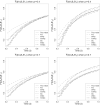Cumulative incidence regression for dynamic treatment regimens
- PMID: 30371745
- PMCID: PMC7868058
- DOI: 10.1093/biostatistics/kxy062
Cumulative incidence regression for dynamic treatment regimens
Abstract
Recently dynamic treatment regimens (DTRs) have drawn considerable attention, as an effective tool for personalizing medicine. Sequential Multiple Assignment Randomized Trials (SMARTs) are often used to gather data for making inference on DTRs. In this article, we focus on regression analysis of DTRs from a two-stage SMART for competing risk outcomes based on cumulative incidence functions (CIFs). Even though there are extensive works on the regression problem for DTRs, no research has been done on modeling the CIF for SMART trials. We extend existing CIF regression models to handle covariate effects for DTRs. Asymptotic properties are established for our proposed estimators. The models can be implemented using existing software by an augmented-data approximation. We show the improvement provided by our proposed methods by simulation and illustrate its practical utility through an analysis of a SMART neuroblastoma study, where disease progression cannot be observed after death.
Keywords: Competing risks; Fine and Gray; Inverse probability weighting; Scheike model; Sequential Multiple Assignment Randomized Trial.
© The Author 2018. Published by Oxford University Press. All rights reserved. For permissions, please e-mail: journals.permissions@oup.com.
Figures



References
-
- Beyersmann J., Allignol A. and Schumacher M. (2012). Competing Risks and Multistate Models with R. New York: Springer. - PubMed
-
- Cheng Y., Fine J. P. and Kosorok M. R. (2009). Nonparametric association analysis of exchangeable clustered competing risks data. Biometrics 65, 385–393. - PubMed
-
- Cox D. R. (1972). Regression models and life-tables. Journal of the Royal Statistical Society. Series B (Methodological) 34, 187–220.
-
- Fine J. P. and Gray R. J. (1999). A proportional hazards model for the subdistribution of a competing risk. Journal of the American Statistical Association 94, 496–509.
Publication types
MeSH terms
Grants and funding
LinkOut - more resources
Full Text Sources

